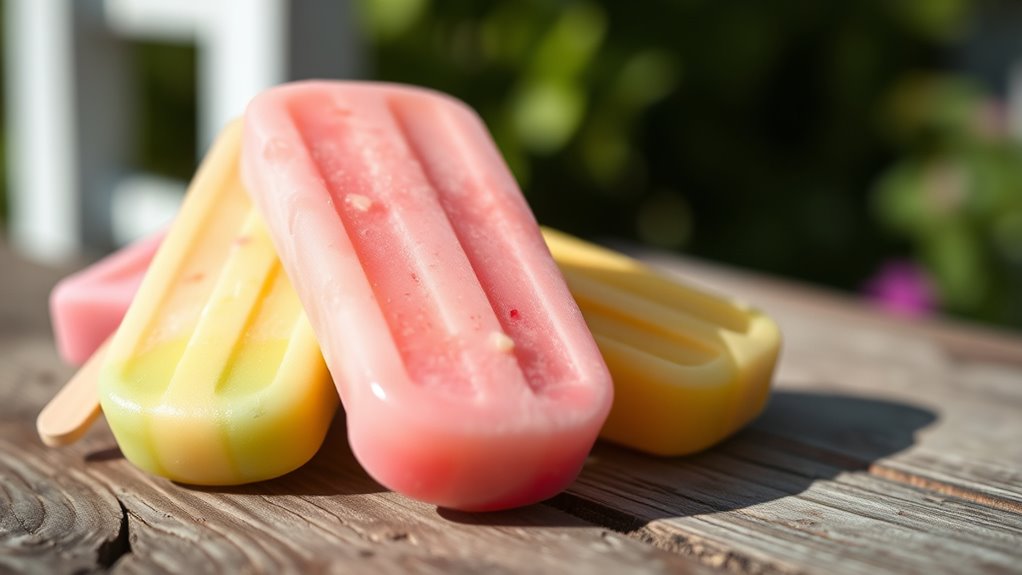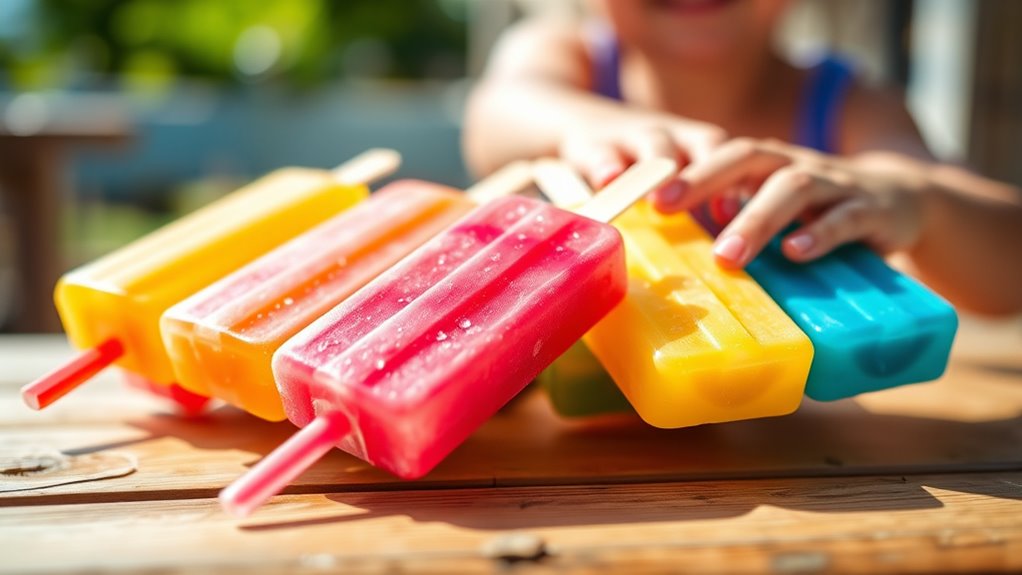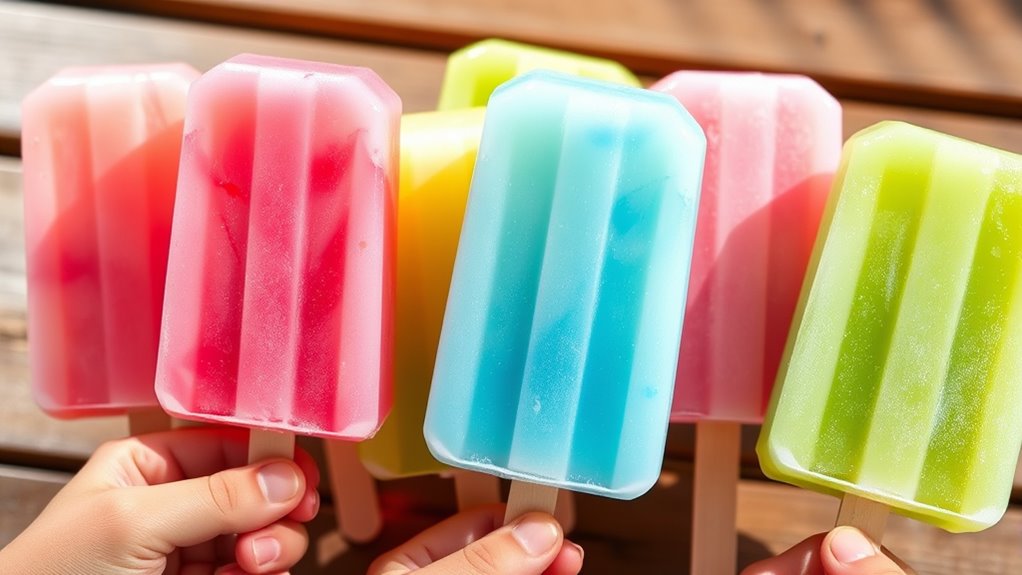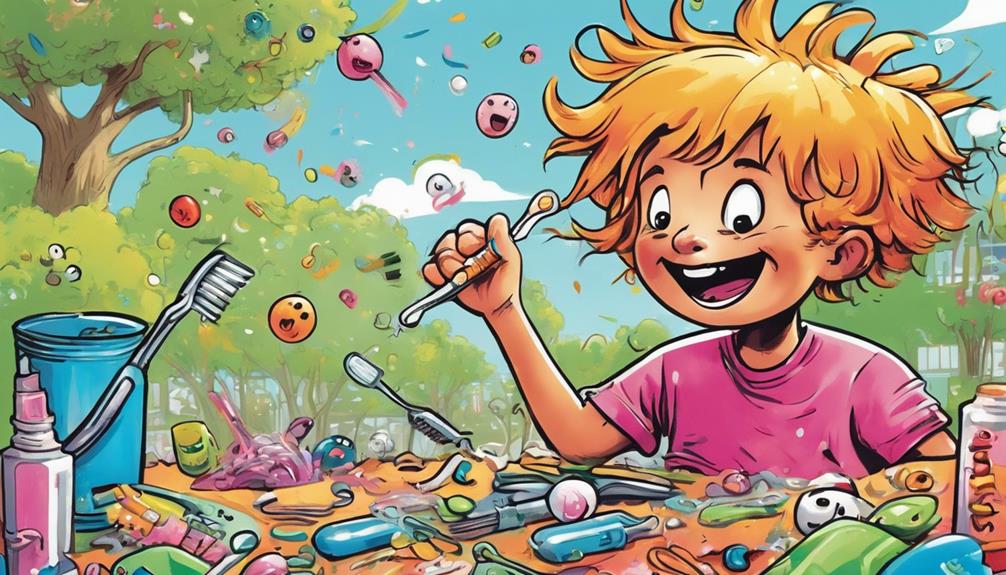To find popsicles that won’t stain little teeth, choose options made from natural fruit juices or purees like berries or mangoes, avoiding artificial dyes and heavy sugars, which can stain teeth and cause decay. Store-bought brands with subtle, natural colors or homemade recipes using healthier ingredients are the safest. Also, consider popsicles that are low in sugar and free of artificial colorings. Keep your child’s teeth safe by exploring simple tips—there’s more to discover below.
Key Takeaways
- Choose popsicles made from real fruit juices or purees with natural, muted colors to prevent staining teeth.
- Opt for store-bought, naturally colored options labeled as tooth-friendly and low in artificial dyes and sugars.
- Make homemade popsicles using fruit purees like mango or berries, avoiding artificial colorings.
- Rinse your child’s mouth with water after eating popsicles to wash away residual sugars and reduce staining risk.
- Incorporate tooth protectors like dental sealants and promote regular brushing to safeguard against stains and decay.
Choosing Naturally Colored Popsicles for Kids

When selecting popsicles for kids, opting for naturally colored options is a smart choice. Many commercial popsicles contain artificial dyes and food coloring, which can stain teeth and may cause sensitivities. By choosing popsicles made from real fruit juices or pureed fruit, you avoid these artificial additives. Naturally colored options often feature vibrant reds, greens, and blues derived from berries, spinach, or beet juice, providing a more wholesome treat. These ingredients not only reduce the risk of staining but also add nutritional benefits. Checking labels or making your own popsicles at home gives you control over the ingredients. This way, you can serve a colorful, tasty treat that’s gentler on your child’s teeth and free from unnecessary artificial food coloring or dyes.
Best Store-Bought Options That Are Tooth-Friendly

Opting for store-bought popsicles that are gentle on your child’s teeth is easier than ever, thanks to many brands now offering tooth-friendly options. These popsicles typically avoid artificial dyes, reducing the risk of staining little teeth and minimizing potential sensitivities. Instead of bright, synthetic colors, they often use natural fruit extracts or subtle hues that won’t leave lasting marks. Additionally, pay attention to sugar content; many brands now produce low-sugar or sugar-free varieties that help prevent cavities and tooth decay. Look for options labeled as “tooth-friendly” or “kid-safe,” and always check the ingredient list. Choosing these store-bought options gives you a convenient, healthy way to treat your child without compromising their dental health. Monitoring options can help you stay informed about your child’s overall health and safety.
DIY Recipes for Stain-Free Frozen Treats

Making your own stain-free frozen treats is a simple and fun way to enjoy cool snacks without worrying about tooth discoloration. To create vibrant, safe popsicles, focus on natural ingredients and avoid artificial flavorings that stain teeth. Use these key tips:
- Choose fruit purees like berries or mangoes for natural color and flavor.
- Replace sugar with alternatives like stevia or erythritol to keep treats sweet without staining.
- Add herbs or extracts (like mint or vanilla) for flavor without artificial additives.
- Consider using headphones to listen to music or audiobooks while preparing or enjoying your frozen treats.
Tips for Protecting Little Teeth During Summer Snacking

During summer snacking, protecting little teeth is essential to prevent decay and staining from sugary or acidic foods. One effective tip is to encourage healthy snack choices with low sugar content, reducing the risk of cavities and staining. Installing dental sealants on your child’s molars creates a protective barrier, shielding teeth from acid attacks and sugar residue. Limit sticky or overly sweet treats that cling to teeth, and rinse their mouth with water after snacking to wash away lingering sugars. Regular brushing with fluoride toothpaste also helps strengthen enamel and remove plaque. Additionally, incorporating AI-powered diagnostic tools can help monitor your child’s oral health more effectively. By being mindful of sugar content and using dental sealants, you support your child’s oral health and keep their little teeth bright and healthy throughout the summer.
When to Consult a Dentist About Children’s Dental Health

Knowing when to consult a dentist about your child’s dental health is essential for catching issues early and maintaining a bright, healthy smile. You should seek professional advice if you notice:
- Signs of tooth decay, such as brown spots or sensitivity.
- Persistent pain or discomfort during eating or brushing.
- Concerns about enamel erosion or ineffective fluoride treatments.
Regular checkups help identify decay before it worsens and ensure your child receives fluoride treatments that strengthen their teeth. Early intervention can prevent future problems and promote healthy habits. If your child’s teeth appear stained or if you notice any changes in their oral health, don’t wait—schedule a dental appointment promptly. Addressing issues early keeps their smile bright and reduces the need for extensive treatments later. Being aware of dental health indicators can help you spot potential problems sooner.
Frequently Asked Questions
Are There Any Artificial Sweeteners Safe for Kids in Popsicles?
When considering artificial sweetener safety, you might wonder if they’re safe for kids in popsicles. It’s best to choose healthy popsicle options that use natural sweeteners like honey or fruit juice, avoiding those with questionable artificial sweeteners. Always read labels carefully, and consult your pediatrician if you’re unsure about a specific ingredient. This way, you guarantee your child enjoys a tasty, safe treat without compromising health.
How Long Should Kids Wait Before Brushing Their Teeth After Eating Popsicles?
When asking about popsicle timing, it’s best to wait about 30 minutes before brushing your kids’ teeth. This brushing delay helps prevent damaging the enamel that’s temporarily softened by the sugar and acids in the popsicle. Rushing to brush immediately can do more harm than good. Encourage your kids to rinse their mouth with water first, then wait, so their teeth stay healthy and strong after enjoying a sweet treat.
Can Certain Flavors Cause More Staining Than Others?
Certain flavors can cause more staining than others due to natural pigments. You might notice darker or brighter colors, like red or purple, that have higher stain potential because these pigments cling more easily to teeth. To protect little teeth, encourage kids to rinse or brush soon after eating colorful treats. Choosing popsicles with less intense or artificial colors can also help reduce staining, keeping their teeth brighter longer.
Are There Specific Ingredients to Avoid in Store-Bought Popsicles for Dental Health?
When choosing store-bought popsicles, you should avoid those with artificial coloring, preservatives, and additives. These ingredients can harm your dental health by increasing the risk of staining and decay. Look for popsicles made with natural ingredients and minimal processing. By paying attention to labels, you help protect your teeth from unnecessary chemicals that could cause long-term damage, keeping your smile healthy and bright.
Do Dental Sealants Protect Against Staining From Frozen Treats?
Dental sealants do help with stain prevention by protecting your teeth’s surface, making it less likely for discoloration from foods or drinks. While they don’t prevent stains entirely, they create a barrier that shields your teeth from potential staining agents in frozen treats. If you’re concerned about staining from popsicles or other treats, talk to your dentist about sealants and maintaining good oral hygiene for the best protection.
Conclusion
Just like the wise owl guards the night, protecting your child’s smile requires mindful choices. By selecting naturally colored popsicles, opting for tooth-friendly store-bought options, or whipping up DIY treats, you’re keeping their teeth safe—think of it as shielding their own Little Mermaid’s treasure chest from stain and decay. Stay vigilant during summer snacking, and when in doubt, consult your dentist. After all, a bright smile is the true treasure of childhood adventures.









